A striking feature of pro tem finance minister Piyush Goyal’s 100-minute budget address to Parliament and the nation on February 1 was that the word ‘education’ was mentioned only once and the allocation for education at Rs.93,807 crore was marginally higher than last year – Dilip Thakore
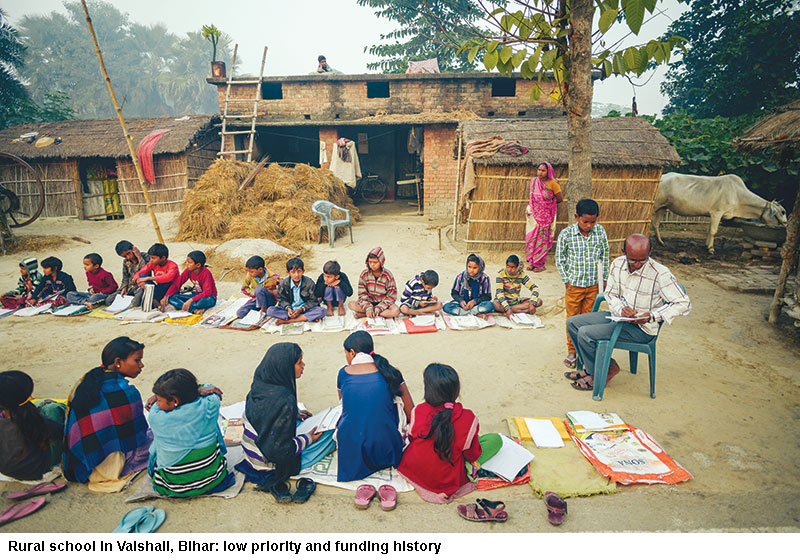 A major infirmity of the Indian State is that its institutions don’t listen to each other. On January 15, the globally respected Delhi/Mumbai-based Pratham Education Foundation (estb.1994), which raises millions of dollars abroad annually to fund its remedial primary education programmes, formally released its Annual Status of Education Report (ASER) 2018. The report — the outcome of the combined effort of 30,000 field personnel, mainly college/university students and NGO volunteers who tested the academic learning outcomes of class I-VIII children of 300,000 households in 596 districts of rural India (the total number of administrative districts countrywide — urban plus rural — is 701), says that 27 percent of children in class VIII cannot read/comprehend class II textbooks, and a mere 44 percent can manage simple three-digits by one-digit division sums.
A major infirmity of the Indian State is that its institutions don’t listen to each other. On January 15, the globally respected Delhi/Mumbai-based Pratham Education Foundation (estb.1994), which raises millions of dollars abroad annually to fund its remedial primary education programmes, formally released its Annual Status of Education Report (ASER) 2018. The report — the outcome of the combined effort of 30,000 field personnel, mainly college/university students and NGO volunteers who tested the academic learning outcomes of class I-VIII children of 300,000 households in 596 districts of rural India (the total number of administrative districts countrywide — urban plus rural — is 701), says that 27 percent of children in class VIII cannot read/comprehend class II textbooks, and a mere 44 percent can manage simple three-digits by one-digit division sums.
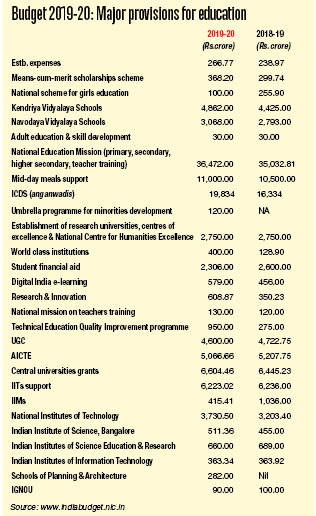 The previous ASER 2017, which in a departure from standard practice assessed the learning outcomes of adolescents aged 14-18 years schooled in rural India, reported that 60 percent couldn’t correctly calculate the price of a shirt sold at a 10 percent discount and/or read the time on an analogue clock. These annual learning surveys of the Pratham Foundation provide telling insights into the capabilities and productivity of the country’s rural citizens who constitute the majority (68 percent) of 21st century India’s 1.3 billion people.
The previous ASER 2017, which in a departure from standard practice assessed the learning outcomes of adolescents aged 14-18 years schooled in rural India, reported that 60 percent couldn’t correctly calculate the price of a shirt sold at a 10 percent discount and/or read the time on an analogue clock. These annual learning surveys of the Pratham Foundation provide telling insights into the capabilities and productivity of the country’s rural citizens who constitute the majority (68 percent) of 21st century India’s 1.3 billion people.
A fortnight later on February 1, Piyush Goyal, Union minister of railways and coal in the BJP-led NDA government, presented the Union Budget 2019-20, the last budget of the incumbent government before General Election 2019 scheduled for this summer. Goyal was standing in for Union finance minister Arun Jaitley who had flown abroad for medical treatment. Technically, it should have been an interim vote-on-account budget for funding government expenditure for the next three months before the general election. But to advertise the BJP/NDA government’s professedly excellent management of the Indian economy during the past five years and to spell out the ruling party’s utopian vision for the future, Goyal presented a full-fledged Union budget to Parliament and the nation.
However a striking feature of the minister’s 100-minute budget address was that the word ‘education’ was mentioned only once, the allocation for education was static (adjusted for inflation) at Rs.93,807 crore and conveyed the impression that the Rt. Hon minister had never heard of ASER 2018 or its predecessor reports which are often released with great fanfare by Union ministers. The detailed ASER surveys — which routinely report that learning outcomes in the country’s 1.20 million government primaries are significantly worse than in private budget rural schools — aside, finance ministry bureaucrats who shaped Union Budget 2019-20 seem equally oblivious of the World Bank’s Human Capital Index and UNDP’s annual Human Development Report which rank India among the contemporary world’s negligent countries for human capital development.
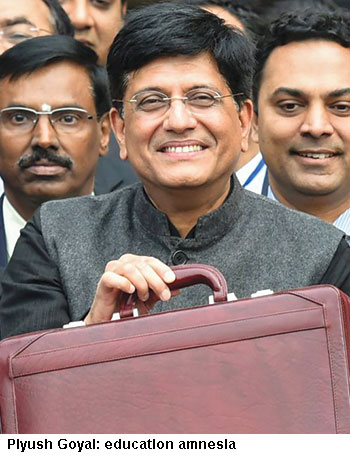
Nor does the leadership of the BJP, which has ensured that the grandiosely titled Union human resource development (HRD) or education ministry housed in Shastri Bhavan, Delhi, is in the grip of trusted party functionaries, seem to have heard of or paid any heed to the warning of economics Nobel laureate (1998) Dr. Amartya Sen about the “centrality of education”. In their seminal book An Uncertain Glory — India and its Contradictions (2013), Sen and co-author Dr. Jean Dreze, former professor at the Delhi School of Economics, wrote: “The role of basic education in the process of development and social progress is very wide and critically important. First the capability to write and count has powerful effects on our quality of life: the freedom to understand the world, to lead an informed life, to communicate with others, and to be generally in touch with what is going on. In a society, particularly in the modern world, where so much depends on the written medium, being illiterate is like being imprisoned, and school education opens a door through which people can escape incarceration.”
Yet despite a mountain of evidence indicating that primary/elementary education is the master key that opens all doors to national socio-economic development — way back in the early 20th century eminent British author H.G. Wells in his Outline of World History (1919) wrote “human history becomes more and more a race between education and catastrophe” — for mysterious reasons all governments at the Centre and the states (with perhaps the exception of the southern state of Kerala) have accorded low priority — and funding — to public primary education. Almost six decades ago in 1966, a high-powered national commission under the chairmanship of Dr. D.P. Kothari, chairman of the University Grants Commission, had recommended that the newly independent nation (Centre plus states) should allocate 6 percent of the country’s GDP (gross domestic product) for public education with emphasis on primary schooling. That advice has never been given any importance by the Congress party which has ruled at the Centre for over half a century, or by the BJP which has served two full terms in office in New Delhi.
In 2014 when in a sharp rejection of the scams and scandals-ridden Congress-led UPA-I and UPA-II coalition governments, the electorate swept the BJP/NDA coalition to power at the Centre with a massive majority, the BJP appointed a committee chaired by the late T.S.R. Subramanian, a former Union cabinet secretary of impeccable credentials, to recommend a draft New Education Policy (NEP) 2016. Working at furious speed the Subramanian Committee completed a comprehensive 200-page NEP draft which inter alia recommended that the annual outlay (Centre plus states) for education is raised to 6 percent of GDP with “immediate effect”. With some of its sensible recommendations to liberalise and deregulate the academy from the death-embrace of supervisory agencies such as UGC, AICTE and CBSE which are packed with government yes-men proving inconvenient for the BJP leadership, the report was transformed into just another “input” for a new NEP draft to be drawn up by a new committee chaired by eminent scientist Dr. K. Kasturirangan. Despite several deadline extensions, the Kasturirangan Committee has failed to submit its report. Or as is rumoured, the BJP leadership is not pleased with this NEP draft either.
Yet after initially displaying resolve to address the issue of downsliding education from preschool to Ph D, regrettably, during the past five years since the BJP/NDA coalition was voted into power with the BJP endowed the largest majority in the Lok Sabha since 1985 in its own right, education has received attention for all the wrong reasons. Specifically for the appointment of scholars of dubious repute and credentials, some of whom cannot distinguish between mythology and history, to head important institutions such as the Indian Council of Historical Research, textbook writing committees, top-ranked universities and the Central Board of Secondary Education (CBSE) among others. Moreover despite the pleas and imprecations of poets, pundits, reputable NGOs, the World Bank and the United Nations, the budgetary allocation for education of the BJP/NDA government has remained almost stagnant in real terms and has reduced from 0.50 percent of GDP in 2014-15 to 0.45 percent in 2019-20.
However, it’s important to note that the record of Congress governments, which have ruled at the Centre and in most states of the Indian Union for over half a century, is hardly better. Since under the leadership of Mahatma Gandhi India wrested independence from British rule in 1947, the annual expenditure for education (Centre plus states) has never exceeded 4 percent of GDP.
In sharp contrast, the global average allocation is 5 percent, with the developed OECD and South-east Asian tiger nations spending 7-10 percent of GDP on education. Although several Indian economics pundits including the influential Swaminathan Aiyar of the Economic Times make a great play about the budgetary allocation of communist China being 2.5 percent of GDP for several decades, it’s pertinent to note that almost 80 percent of it is expended on school education, whereas in post-independence India 33-35 percent of the national budgetary outlay is spent on higher education. Moreover in recent years, China has sharply increased its public education expenditure. According to EducationWorld’s Beijing columnist Li Liang, the People’s Republic has recently increased its public education budget to 4.4 percent of GDP with spectacular grants for its top-ranked universities (see EW February p.36). It’s also pertinent to note that China’s GDP is five times greater than India’s.
Continuous disinterest in raising the bar in primary and adult education has lumbered 21st century India with the largest low-productivity workforce of the contemporary world. Writing in the Economic & Political Weekly (January 19) research scholars Pankaj Vashisht and Jaydev Dube say that in 2011-12, 30 percent of India’s 420 million labour force was illiterate, only 13.33 percent completed primary school, 16.45 percent middle school, 11.81 percent high school with a mere 8.79 percent being graduates and postgrads. Moreover if one takes the pathetic learning outcomes of children who complete school and even college/university education — Aspiring Minds, a Delhi-based recruitment and skills assessment company, says that 85 percent of liberal arts graduates and 75 percent of engineering grads are unemployable in Indian and foreign multinationals — it’s hardly surprising that Indian industry and agriculture productivity is rock-bottom by global standards. While it’s well-documented that shop-floor productivity of Indian labour is one-tenth of workers in the US, in his recently published memoir Of Counsel: Challenges of Working with the Modi-Jaitley Government (2018), former chief economic adviser (CEA) of the incumbent BJP/NDA government, Arvind Subramanian laments that per-hectare rice yields in India’s best agriculture states are half of China’s and one-third of the US, Japan and European countries.
Despite this overwhelming evidence of the damage inflicted upon the economy and the poor productivity of the population because of neglect of public education, the Union Budget 2019-20 allocates a mere Rs.93,807 crore for education of which Rs.36,322 crore is earmarked for preschool to class XII Samagra Shiksha Abhiyan (SMSA) programme launched last year. In addition the Central government has budgeted Rs.11,000 crore for the mid-day meal scheme, Rs.4,862 crore for its 1,199 Kendriya Vidyalaya schools established countrywide for government employees in transferable jobs; Rs.3,068 crore for its 598 Jawahar Navodaya Vidyalayas (free-of-charge rural boarding schools for meritorious students) and Rs.37,461 crore for higher education.
The Delhi-based think tank Centre for Budget and Governance Accountability (CBGA, estb. 2002), which closely monitors and analyses the Union budget every year, is unimpressed by Union Budget 2019-20. In its monograph titled Numbers that Count — An Assessment of the Budgets of NDA II published shortly after Goyal presented the budget to Parliament and the people on February 1, the authors highlight that the Central government’s outlay for education as a percentage of total budgetary expenditure has declined from 4.6 to 3.5 and as a percentage of GDP from 0.55 to 0.45 since 2014. However they concede that this may be because as per the recommendation of the 14th Finance Commission (2015), the Centre has increased states’ share from its pool of divisible taxes to 42 percent as against 32 percent earlier, following which most states have expanded their education budgets.
Nevertheless, the authors of Numbers that Count are unimpressed by the Modi government’s education track record. “School education for the past few years is suffering from deteriorating learning levels of students. The focus of education policies in the last five years has shifted from input-based to outcome oriented. NITI Aayog’s Three Years Action Agenda envisioned ‘Right to Education’ as ‘Right to Learning’. However, in the process of improving learning outcomes, the NDA government has continuously ignored the supply side bottlenecks. Among them, the most crucial remains shortage of professionally qualified teachers. There is a shortage of more than 500,000 teachers at the elementary level,” says the monograph.
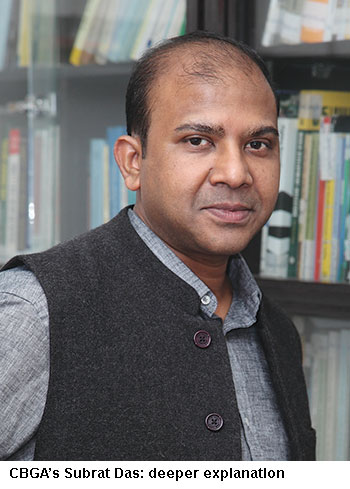 Subrat Das, executive director of CBGA, has a deeper explanation for the continuous neglect of public elementary education by successive administrations of post-independence India. “A major reason why government budgetary allocations for public education have been meagre is that India’s tax-GDP ratio has been stagnant at 17 percent since 1990. The failure of the Central government to widen the tax base obliges corporates and households to spend a higher proportion of GDP. In sharp contrast in developed OECD countries which have substantially greater tax revenues, government spending is 40-45 percent of GDP against India’s 27 percent. This enables them to make greater provision for public education, health and social services. Moreover flawed implementation of education policies and poor utilisation of budgeted allocations has adversely affected learning outcomes,” says Das, an economics alumnus of JNU who was appointed executive director of CBGA in 2010.
Subrat Das, executive director of CBGA, has a deeper explanation for the continuous neglect of public elementary education by successive administrations of post-independence India. “A major reason why government budgetary allocations for public education have been meagre is that India’s tax-GDP ratio has been stagnant at 17 percent since 1990. The failure of the Central government to widen the tax base obliges corporates and households to spend a higher proportion of GDP. In sharp contrast in developed OECD countries which have substantially greater tax revenues, government spending is 40-45 percent of GDP against India’s 27 percent. This enables them to make greater provision for public education, health and social services. Moreover flawed implementation of education policies and poor utilisation of budgeted allocations has adversely affected learning outcomes,” says Das, an economics alumnus of JNU who was appointed executive director of CBGA in 2010.
Disappointment with the BJP/NDA government’s education track record and its indifference to developing the country’s abundant and high potential human resources is widespread. “The interim Union Budget 2019-20 is a huge disappointment. The share of the Union government’s allocation for education in the total budget has decreased from 4.6 percent in 2014-15 to 3.5 percent this year. Since its 2015-16 budget, the BJP-led NDA government has made it evident that public education is a low priority of the Central government. Although in its 2014 election manifesto the BJP promised to increase national — Centre plus states — outlay for education to 6 percent of GDP, its 2019-20 budget reflects the government’s shrinking responsibility towards education. A mere Rs.36,322 crore has been allocated to the Samagra Shiksha Abhiyan i.e, primary, secondary and higher secondary education, which is nowhere near sufficient to universalise school education up to class XII. The marginal increase of less than Rs.6,000 crore over 2018-19 is far below the minimum amount required to fulfil gaps like 1 million teacher 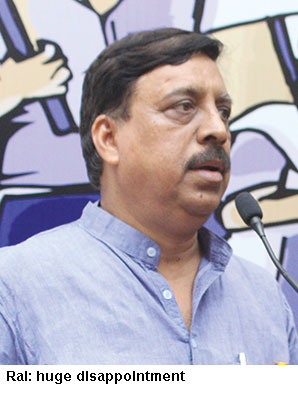 vacancies in public primaries, training of millions of teachers and the infrastructural deficit in public K-12 education,” says Ambarish Rai, national convenor of the RTE Forum, a coalition of over 10,000 NGOs, educationists and social activists gathered under the forum’s banner to enforce the landmark Right of Children to Free & Compulsory Education (RTE) Act, 2009 in all of India’s 1.50 million schools.
vacancies in public primaries, training of millions of teachers and the infrastructural deficit in public K-12 education,” says Ambarish Rai, national convenor of the RTE Forum, a coalition of over 10,000 NGOs, educationists and social activists gathered under the forum’s banner to enforce the landmark Right of Children to Free & Compulsory Education (RTE) Act, 2009 in all of India’s 1.50 million schools.
Yet despite having failed to produce a New Education Policy or step up government spending on public education, and seemingly oblivious of contemporary India’s near bottom rankings on the human capital development reports of the World Bank, UNDP and our own Pratham Foundation, in his Budget 2019-20 address, pro tem finance minister Piyush Goyal unfolded an ambitious ten-point Vision Plan for the Next Decade ending 2030.
Goyal’s first ‘dimension’ of this vision plan “for a ten trillion dollar economy” is to ensure that “on the social infrastructure side, every family will have a roof over its head and will live in a healthy, clean and wholesome environment. We will also build a quality science-oriented educational system with Institutes of Excellence providing leadership at the top”, he intoned.
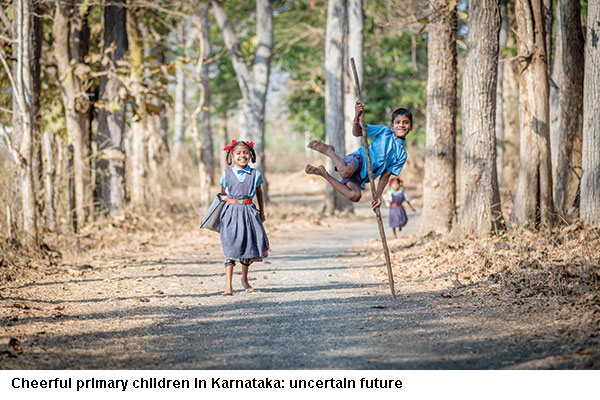
Among the other dimensions or goals of the BJP/NDA government (on the assumption that the BJP/NDA coalition is re-elected to office this summer) spelt out in its Vision Plan: to create a digital India; make India pollution-free “with green Mother Earth and blue skies”; generate massive rural employment by “expanding rural industrialisation using modern digital technologies”; clean rivers and safe drinking water; expanding the blue economy through development of coastal areas and inland waterways; developing India’s outer space programme; making the country self-sufficient in food production — “exporting to the world to meet their food needs”; a healthy India through rollout of the Ayushman Bharat health insurance scheme, and transforming India into a minimum government maximum governance nation through a “proactive responsible bureaucracy which will be viewed as friendly to the people”.
“With this comprehensive ten-dimensional Vision, we will create an India where poverty, malnutrition, littering and illiteracy would be a matter of the past. India will be a modern, technology-driven, high growth, equitable and transparent society,” Goyal assured Parliament and the nation.
Yet while banking reforms, cleanliness, farmers’ progress, women’s development, defence, infrastructure development and even entertainment are given subject heads in Goyal’s 100-minute budget speech, the word ‘education’ is hardly mentioned, let alone given a separate subject head with the provision of Rs.93,807 crore for education not mentioned or deemed worthy of comment. In the circumstances while the minister deserves congratulations for his sunny optimism and capacity to dream big, his belief that the utopian goals articulated by him in Vision Plan 2030 can be realised without developing the country’s run-down human capital resource is fanciful, if not absurd.
“Adequate budgetary provisioning for basic public education is critical for national development. Progressive OECD 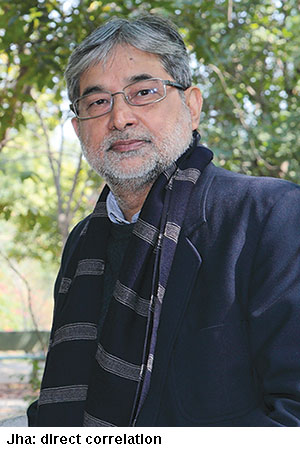 countries, almost without exception spend substantial portions of their GDP on primary education. For instance, among high-income countries, France, Netherlands and the US consistently spent close to 6 percent of GDP on public primary education in the period 2000-2011 according to Unesco data. Public spending per child in primary education, in terms of US dollars, adjusted for purchasing power parity is almost 50 times more in the US than in India. Even middle income countries such as South Africa and Brazil with whom India is bracketed in BRICS, spend seven to ten times more per child in public primaries. Per-child expenditure in government schools even in several low-income countries such as Bhutan, Mongolia and Sri Lanka is higher than in India. Even after seven decades of independence, India has not been able to wipe out illiteracy and we have the dubious distinction that every third illiterate in the world is Indian. Inadequate provisioning for basic public education has diluted learning outcomes in school and higher education and is directly correlated to the poor productivity of Indian industry, agriculture and services,” says Dr. Praveen Jha, professor of economics at the top-ranked Jawaharlal Nehru University, Delhi.
countries, almost without exception spend substantial portions of their GDP on primary education. For instance, among high-income countries, France, Netherlands and the US consistently spent close to 6 percent of GDP on public primary education in the period 2000-2011 according to Unesco data. Public spending per child in primary education, in terms of US dollars, adjusted for purchasing power parity is almost 50 times more in the US than in India. Even middle income countries such as South Africa and Brazil with whom India is bracketed in BRICS, spend seven to ten times more per child in public primaries. Per-child expenditure in government schools even in several low-income countries such as Bhutan, Mongolia and Sri Lanka is higher than in India. Even after seven decades of independence, India has not been able to wipe out illiteracy and we have the dubious distinction that every third illiterate in the world is Indian. Inadequate provisioning for basic public education has diluted learning outcomes in school and higher education and is directly correlated to the poor productivity of Indian industry, agriculture and services,” says Dr. Praveen Jha, professor of economics at the top-ranked Jawaharlal Nehru University, Delhi.
Nevertheless the situation is not irretrievable. For several years in our annual Union budget analysis issue, EducationWorld has been suggesting ways and means to rework the budget by slashing some items of expenditure, reducing unmerited subsidies, raising additional revenue through modest additional taxation, and more aggressive disinvestment of loss-making or sub-optimal performing public sector enterprises. For mysterious reasons this annual exercise has not evoked any reaction from the academy, intelligentsia or government.
However one of the few academics who believes that subsidies can be — and should be — pruned to mobilise additional resources for human capital development, is Dr. A.S. Seetharamu, an economics alumnus of Mysore University and former professor of education at the Bangalore-based Institute of Social & Economic Change (ISEC), established in 1974 by renowned economist Dr. V.R.K.V Rao.
“There is substantial wasteful expenditure under several heads that can be reduced to deploy savings into education and human capital development which should be the highest priority of the Central government. For instance subsidies for petroleum products and fertilisers aggregate a massive Rs.112,374 crore. Moreover, establishment expenses at Rs.5.41 lakh crore, which consume 19.43 percent of the total Rs.27.84 lakh crore expenditure of the Central government, offer considerable scope for pruning, provided there is political will to do so. Within the political class there is unwarranted apprehension that rationalisation of subsidies for investment in school education will prove electorally expensive. On the contrary I believe that investment in education and health of children is likely to prove electorally rewarding, because as the flight of children across the country from dysfunctional government to private budget schools indicates, parents are desperate to provide their children good quality education,” says Seetharamu.
For the past five years soon after the Union Budget has been presented to Parliament and the nation, this publication 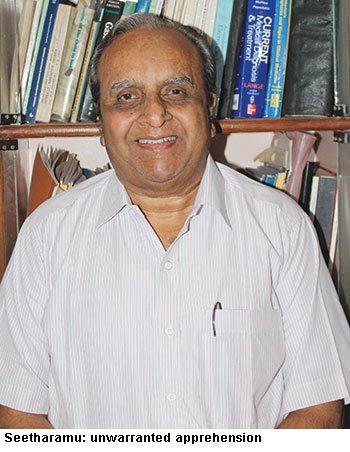 has been presenting a schema to mobilise funding for human capital development by reducing government expenditure and raising dedicated revenue. This year is no exception. Despite no response from ivory tower academics, apathetic intelligentsia and the time-serving neta-babu brotherhood, we once again present a monograph which provides a road map to raise a substantial sum of Rs.6.37 lakh crore for investment in developing the country’s high-potential but criminally neglected human resources (see box p.82). The apprehensions of sceptical politicians and head-in-the-sand intelligentsia who believe the country’s long-suffering citizenry will begrudge making small sacrifices to secure good quality education for the world’s largest child and youth population, are unwarranted. There is abundant historical and anecdotal evidence which indicates that the vast majority of the country’s 200 million households are ready, willing and able to put their children first.
has been presenting a schema to mobilise funding for human capital development by reducing government expenditure and raising dedicated revenue. This year is no exception. Despite no response from ivory tower academics, apathetic intelligentsia and the time-serving neta-babu brotherhood, we once again present a monograph which provides a road map to raise a substantial sum of Rs.6.37 lakh crore for investment in developing the country’s high-potential but criminally neglected human resources (see box p.82). The apprehensions of sceptical politicians and head-in-the-sand intelligentsia who believe the country’s long-suffering citizenry will begrudge making small sacrifices to secure good quality education for the world’s largest child and youth population, are unwarranted. There is abundant historical and anecdotal evidence which indicates that the vast majority of the country’s 200 million households are ready, willing and able to put their children first.
Although pro tem finance minister Piyush Goyal, who presented yet another business-as-usual Union budget high on utopian rhetoric but which completely ignores the greatest challenge confronting the nation and the economy, doesn’t seem to be aware, leveraging the country’s demographic advantage through high quality education and health services provision is gradually but inexorably becoming a top priority. Even if post-independence India’s establishment and intelligentsia has failed to heed the warnings of prophets and pundits that the continuous downslide of the education system from preschool to PhD is pushing 21st century India towards an era of domestic strife and turmoil and international irrelevance, the people are moving education ever higher in their household budgets.
Budget 2019-20 reactions
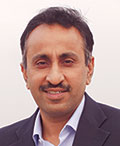 This year’s budget announcement of 1 lakh digital villages to be created by the government in the next five years is a very positive sign. With the availability of voice and data, digital platforms can reach these remote villages and provide classroom experience of top universities in them — Aditya Malik, CEO & MD, Talentedge, Gurgaon
This year’s budget announcement of 1 lakh digital villages to be created by the government in the next five years is a very positive sign. With the availability of voice and data, digital platforms can reach these remote villages and provide classroom experience of top universities in them — Aditya Malik, CEO & MD, Talentedge, Gurgaon
 Piyush Goyal has maintained a delicate balance between the urban and rural sectors in this budget. He has provided much-needed stimulus to the Indian economy in the form of tax reliefs and this I believe in turn will boost consumption — Dr. Ajeenkya Patil, chairman, Ajeenkya D. Y. Patil Group, Pune
Piyush Goyal has maintained a delicate balance between the urban and rural sectors in this budget. He has provided much-needed stimulus to the Indian economy in the form of tax reliefs and this I believe in turn will boost consumption — Dr. Ajeenkya Patil, chairman, Ajeenkya D. Y. Patil Group, Pune
Unfortunately, the benefits offered to the education sector hardly go beyond those in previous years. However, the emphasis on Internet connectivity and low data costs will increase access of online education to lesser served locations in India — Akhil Shahani, managing director, Shahani Group, Mumbai
 The interim Union Budget 2019-20 has brought cheer to the middle class and farmers given its focus on the National Education Mission. This will provide a great push to Sakshar Bharat, Sarva Shiksha Abhiyan, Rashtriya Madhyamik Shiksha Abhiyan and teacher training programmes, the four prominent schemes under the National Education Mission — Shweta Sastri, managing director, Canadian International School, Bangalore
The interim Union Budget 2019-20 has brought cheer to the middle class and farmers given its focus on the National Education Mission. This will provide a great push to Sakshar Bharat, Sarva Shiksha Abhiyan, Rashtriya Madhyamik Shiksha Abhiyan and teacher training programmes, the four prominent schemes under the National Education Mission — Shweta Sastri, managing director, Canadian International School, Bangalore
 This is an interim budget focused on the next election. For the education sector, it is a major disappointment. In order to incorporate the additional 10 percent quota, there is a burden on universities to increase their seats by 25 percent without any allocation in the budget for enhancing infrastructure, faculty, and other resources required — Kapil Rampal, director, Ivory Education, New Delhi
This is an interim budget focused on the next election. For the education sector, it is a major disappointment. In order to incorporate the additional 10 percent quota, there is a burden on universities to increase their seats by 25 percent without any allocation in the budget for enhancing infrastructure, faculty, and other resources required — Kapil Rampal, director, Ivory Education, New Delhi
The government has presented a pro-citizen budget with emphasis on taxation, rural economy, education, agriculture and infrastructure. We welcome the increased budgetary allocation for the National Education Mission. The government’s focus on digitisation of villages is also a step in the right direction and will propel digital education in rural India — Vikas Singh, managing director, Pearson India, Bangalore
The interim Budget has identified health as one of the Top 9 priority areas while education remains an important focus area. The government should consider allocating grants from health and education budgets to improving school sports and physical education as well as improving playgrounds in cities and towns — Saumil Majmudar, CEO, EduSports, Pune
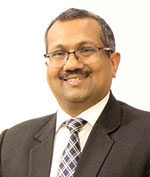 Overall, the Union Budget is focused on people, progress and prosperity and that will lead to the rise of a New India by 2022. The reduction of interest payable on education loans is a good move towards ensuring education for all. At the same time, the allocation for the Higher Education Financing Agency (HEFA) has been reduced from Rs.2,750 crore last year to Rs.2,100 crore this year. More focused announcements around skilling and higher education for youth would have made the Budget more holistic — Dr. Sanjay Gupta, vice chancellor, World University of Design, Sonipat
Overall, the Union Budget is focused on people, progress and prosperity and that will lead to the rise of a New India by 2022. The reduction of interest payable on education loans is a good move towards ensuring education for all. At the same time, the allocation for the Higher Education Financing Agency (HEFA) has been reduced from Rs.2,750 crore last year to Rs.2,100 crore this year. More focused announcements around skilling and higher education for youth would have made the Budget more holistic — Dr. Sanjay Gupta, vice chancellor, World University of Design, Sonipat
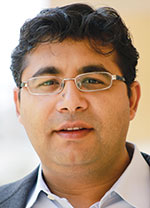 The government has taken a welcome step by declaring a nationwide programme on artificial intelligence (AI) in the Union Budget 2019-20. This will help us catch up with leading nations such as the US and China, who are using AI and data sciences to personalise education — Beas Dev Ralhan, CEO and founder, NextEducation India Pvt. Ltd, Hyderabad
The government has taken a welcome step by declaring a nationwide programme on artificial intelligence (AI) in the Union Budget 2019-20. This will help us catch up with leading nations such as the US and China, who are using AI and data sciences to personalise education — Beas Dev Ralhan, CEO and founder, NextEducation India Pvt. Ltd, Hyderabad
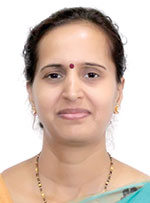 The provision for education has been hiked by Rs.10,222 crore. Taking changing dynamics of employment by artificial intelligence, the government has announced a policy for artificial intelligence. This will be catalysed by establishment of the National Centre on Artificial Intelligence as a hub along with centers of excellence — Dr. Shailashree Haridas, associate director, MIT School of Government (MIT-WPU), Pune
The provision for education has been hiked by Rs.10,222 crore. Taking changing dynamics of employment by artificial intelligence, the government has announced a policy for artificial intelligence. This will be catalysed by establishment of the National Centre on Artificial Intelligence as a hub along with centers of excellence — Dr. Shailashree Haridas, associate director, MIT School of Government (MIT-WPU), Pune
It is heartening to see the government’s continued efforts to further its digitisation agenda aligning with the vision of creating a Digital India. While the move will help India create millions of jobs in the next few years, it should also address the need of getting the current talent pool global-ready for tomorrow — Krishna Kumar, founder and CEO, Simplilearn, Bangalore
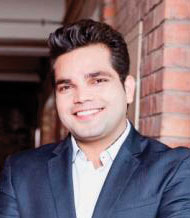 With great commitment to harness the potential of our youth and secure their future, the investment of Rs.38,572 crore under the National Education Mission, is indeed very welcome. Moreover the initiative of deduction of interest paid on education loans will make education accessible to all — Prashant Gupta, executive director, Sharda University, Gautam Buddha Nagar, UP
With great commitment to harness the potential of our youth and secure their future, the investment of Rs.38,572 crore under the National Education Mission, is indeed very welcome. Moreover the initiative of deduction of interest paid on education loans will make education accessible to all — Prashant Gupta, executive director, Sharda University, Gautam Buddha Nagar, UP
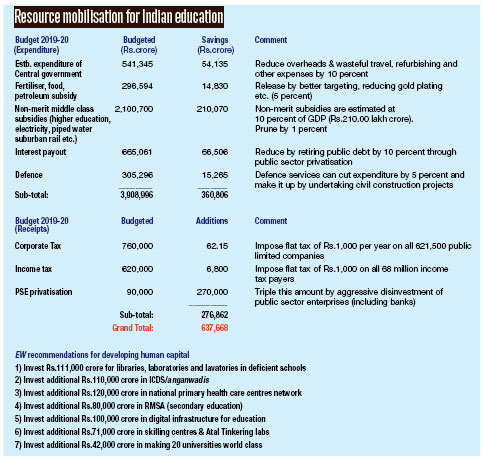
Also read: Union Budget 2021-22: Bare cupboard for world’s high-potential children























